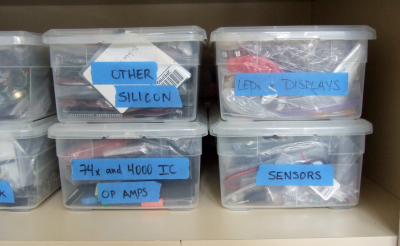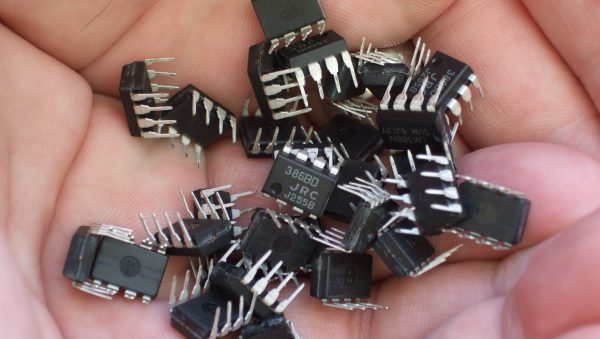Are robotaxis poised to be the Next Big Thing™ in North America? It seems so, at least according to Goldman Sachs, which issued a report this week stating that robotaxis have officially entered the commercialization phase of the hype cycle. That assessment appears to be based on an analysis of the total ride-sharing market, which encompasses services that are currently almost 100% reliant on meat-based drivers, such as Lyft and Uber, and is valued at $58 billion. Autonomous ride-hailing services like Waymo, which has a fleet of 1,500 robotaxis operating in several cities across the US, are included in that market but account for less than 1% of the total right now. But, Goldman projects that the market will burgeon to over $336 billion in the next five years, driven in large part by “hyperscaling” of autonomous vehicles.
hoarding4 Articles
Hackaday Links: November 21, 2021
As the most spendiest time of the year rapidly approaches, it’s good to know that your hard-earned money doesn’t have to go towards gifts that are probably still sitting in the dank holds of container ships sitting at anchor off the coast of California. At least not if you shop the Tindie Cyber Sale that started yesterday and goes through December 5. There’s a lot of cool stuff on sale, so it shouldn’t be too hard to find something; to sweeten the deal, Jasmine tells us that there will be extra deals going live on Black Friday and Cyber Monday. But wait, there’s more — follow Tindie on Twitter for bonus discount codes.
Blue is the old black, which was the new blue? At least when it comes to “Screens of Death” it is, since Microsoft announced the Windows 11 BSOD will revert back from its recent black makeover to the more familiar blue theme. You’ll have to scroll down a bit, perhaps three-quarters of the way through the list of changes. Again, the change seems completely cosmetic and minor, but we’d still love to know what kind of research went into making a decision like this.
From the “One Man’s Trash” department, we have a request for help from reader Mike Drew who picked up a bunch — like, a thousand — old tablet computers. They originally ran Windows but they can run Linux Mint just fine, and while they lack batteries and the back cover, they’re otherwise complete and in usable condition, at least judging by the pictures he shared. These were destined for the landfill, but Mike is willing to send batches of 10 — no single units, please — to anyone who can cover the cost of packaging and shipping. Mike says he’ll be wiping the tablets and installing Mint, and will throw in a couple of battery cables and a simple instruction sheet to get you started. If you’re interested, Mike can be reached at michael.l.drew@gmail.com. Domestic shipping only, please. Here’s hoping you can help a fellow hacker reclaim a room in his house.
Answering the important questions: it turns out that Thanos couldn’t have snapped half of the universe out of existence after all. That conclusion comes from a scientific paper, appearing in the Journal of the Royal Society. While not setting out to answer if a nigh-invulnerable, giant purple supervillain could snap his fingers, it’s pretty intuitive that wearing any kind of gloves, let alone a jewel-encrusted metal gauntlet, makes it hard to snap one’s fingers. But the mechanics of snapping is actually pretty cool, and has implications beyond biomechanics. According to the paper, snapping is actually an example of latch-mediated spring actuation, with examples throughout the plant and animal kingdoms, including the vicious “one-inch punch” of the tiny mantis shrimp. It turns out that a properly executed human finger snap is pretty darn snappy — it takes about seven milliseconds to complete, compared to 150 milliseconds for an eye blink.
And finally, it seems like someone over at Id Software is a bit confused. The story began when a metal guitarist named Dustin Mitchell stumbled across the term “doomscroll” and decided that it would make a great name for a progressive thrash metal band. After diligently filing a trademark application with the US Patent and Trademark Office, he got an email from an attorney for Id saying they were going to challenge the trademark, apparently because they feel like it will cause confusion with their flagship DOOM franchise. It’s hard to see how anyone who lived through the doomscrolling years of 2020 and 2021 is going to be confused by a thrash metal band and a 30-year-old video game, but we suppose that’s not the point when you’re an attorney. Trademark trolls gonna troll, after all.
Hardware Hacker’s Marie Kondo: How Many LM386s Is Too Many?
We’re running a contest on Making Tech at Home: building projects out of whatever you’ve got around the house. As a hacker who’s never had a lab outside of my apartment, house, or hackerspace, I had to laugh at the premise. Where the heck else would I hack?
 The idea is that you’re constrained to whatever parts you’ve got on hand. But at the risk of sounding like Scrooge McDuck sitting on a mountain of toilet paper, I’ve got literally hundreds of potentiometers in my closet, a couple IMUs, more microcontrollers than you can shake a stick at, and 500 ml of etching solution waiting for me in the bathroom. Switches, motors, timing belts, nichrome wire…maybe I should put in an order for another kilogram of 3D printer filament. In short, unless it’s a specialty part or an eBay module, I’m basically set.
The idea is that you’re constrained to whatever parts you’ve got on hand. But at the risk of sounding like Scrooge McDuck sitting on a mountain of toilet paper, I’ve got literally hundreds of potentiometers in my closet, a couple IMUs, more microcontrollers than you can shake a stick at, and 500 ml of etching solution waiting for me in the bathroom. Switches, motors, timing belts, nichrome wire…maybe I should put in an order for another kilogram of 3D printer filament. In short, unless it’s a specialty part or an eBay module, I’m basically set.
But apparently not everyone is so well endowed. I’ve heard rumors of people who purchase all of the parts for a particular project. That ain’t me. The guru of household minimalism asks us to weigh each object in our possession and ask “does it spark joy?”. And the answer, when I pull out the needed 3.3 V low-dropout regulator and get the project built now instead of three days from now, is “yes”.
And I’m not even a hoarder. (I keep telling myself.) The rule that keeps me on this side of sanity: I have a box for each type of part, and they are essentially fixed. When no more motors fit in the motor box, no more motors are ordered, no matter how sexy, until some project uses enough of them to free up space. It’s worked for the last 20 years, long before any of us had even heard of Marie Kondo.
 So if you also sit atop a heap of VFD displays like Smaug under the Lonely Mountain, we want to see what you can do. If you do win, Digi-Key is sending you a $500 goodie box to replenish your stash. But even if you don’t win, you’ve freed up space in the “Robot Stuff” box. That’s like winning, and you deserve some new servos. Keep on hacking!
So if you also sit atop a heap of VFD displays like Smaug under the Lonely Mountain, we want to see what you can do. If you do win, Digi-Key is sending you a $500 goodie box to replenish your stash. But even if you don’t win, you’ve freed up space in the “Robot Stuff” box. That’s like winning, and you deserve some new servos. Keep on hacking!
Too Good To Throw Away: Dealing With An Out-Of-Control Junk Hoard
There it was, after twenty minutes of turning the place over, looking through assorted storage boxes. A Thinwire Ethernet network. About the smallest possible Thinwire Ethernet network as it happens, a crimped BNC lead about 100mm long and capped at each end by a T-piece and a 50 ohm terminator. I’d been looking for a BNC T-piece on which to hook up another terminator to a piece of test equipment, and I’d found two of them.
As I hooked up the test I wanted to run I found myself considering the absurdity of the situation. I last worked somewhere with a Thinwire network in the mid 1990s, and fortunately I am likely to never see another one in my life. If you’ve never encountered Thinwire, be thankful. A single piece of co-ax connecting all computers on the network, on which the tiniest fault causes all to fail.
So why had I held on to all the parts to make one, albeit the smallest possible variant? Some kind of memento, to remind me of the Good Old Days of running round an office with a cable tester perhaps? Or was I just returning to my past as a hoarder, like a Tolkienic dragon perched atop a mountain of electronic junk, and not the good kind of junk?
Continue reading “Too Good To Throw Away: Dealing With An Out-Of-Control Junk Hoard”














